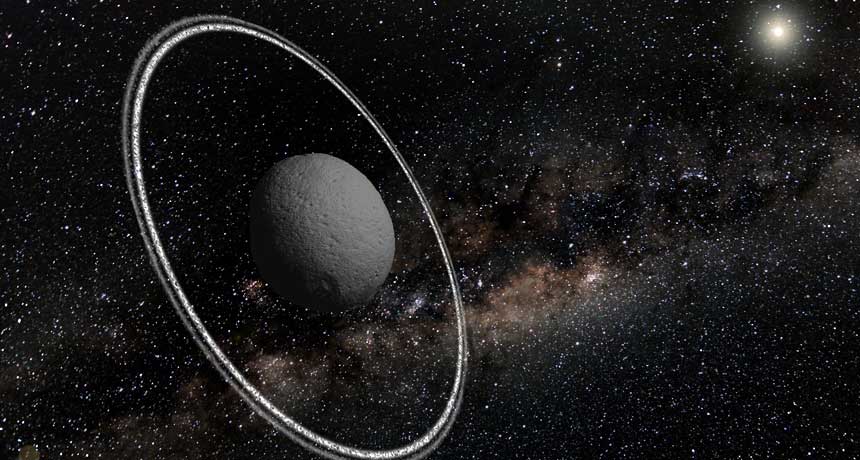Icy rings found around tiny space rock
Surprise discovery reveals belt around planetoid orbiting between Saturn and Uranus

PUT A RING ON IT A pair of thin, icy rings loop around the 250-kilometer-wide planetoid Chariklo, shown in an artist’s illustration.
Lucie Maquet
- More than 2 years ago
All of the giant planets in our solar system — Jupiter, Saturn, Uranus and Neptune — are adorned with rings. Now a much smaller planetoid can take its place on the list of ringed objects. It is the first time rings have been found around such a small object.
Astronomers have discovered a pair of thin rings encircling 10199 Chariklo, a rock-and-ice asteroid-comet hybrid known as a centaur. Chariklo is about 250 kilometers across and orbits the sun between Saturn and Uranus. The rings are probably the result of a collision, astronomers think.
The rings revealed themselves during an occultation — a chance alignment between Chariklo and a distant star when viewed from Earth. When seen from multiple vantage points, an occultation can tell researchers about the size and shape of the intervening body. Felipe Braga-Ribas, an astronomer at Observatório Nacional in Rio de Janeiro, coordinated occultation observations on June 3, 2013, with over a dozen telescopes scattered across South America.
The researchers expected to see a dip in the starlight as the centaur passed in front of the star. What they didn’t expect was a pair of dips just before and another just after the main event. The additional flickers meant something else was traveling with Chariklo. “It was a big surprise,” says Braga-Ribas. “We weren’t looking for it.” By combining all the observations, the team inferred the presence of a double ring composed mostly of water ice. The observations appear March 26 in Nature.
“There’s no doubt that there’s a ring,” says David Jewitt, an astronomer at UCLA who was not involved in the study. “But nobody knows what it means.” Even planetary rings are an enigma, he says. Chariklo’s rings have a few possible origins. In one scenario, another body smashed into Chariklo, excavating ice from the centaur’s interior. Alternatively, Chariklo’s gravity may have torn apart an icy moon orbiting the centaur. Or two moons could have collided.
Regardless of the cause, Braga-Ribas and Jewitt agree that unseen moons probably orbit Chariklo, keeping the rings in shape. Unless confined by the gravity from “shepherd moons,” the rings would be quickly torn apart by Chariklo’s gravity, collisions and radiation pressure from the sun.
Jewitt says that the rings mesh well with what astronomers already know about the outer solar system. Chariklo most likely came from the Kuiper belt, an icy debris field beyond Neptune, before settling into its current orbit. Many Kuiper belt objects are known to have at least one moon. A ring, he says, is the next logical step.
The rings also help explain Chariklo’s recent odd behavior. From 1997 to 2008, the centaur grew fainter and its amount of ice apparently decreased. After 2008, it gradually returned almost to normal. The new observations suggest that in 2008, the rings would have appeared edge-on as seen from Earth. Chariklo appeared fainter because the rings blocked some of its light. The ice, which researchers now know is mostly in the rings and not on Chariklo’s surface, appeared to vanish when only the rings’ edge presented itself.
Since astronomers haven’t observed many centaur occultations and have already found a ring, Jewitt says, the odds are that rings may be relatively common. Braga-Ribas agrees. “We don’t think it’s the only one,” he says. “We may have others.”
NEW RING Astronomers discovered a pair of rings around the asteroid-comet hybrid Chariklo when it momentarily blocked the light of a distant star, this animation shows. Credit: Lucie Maquet, F. Braga-Ribas et al/Nature 2014, adapted by Ashley Yeager







